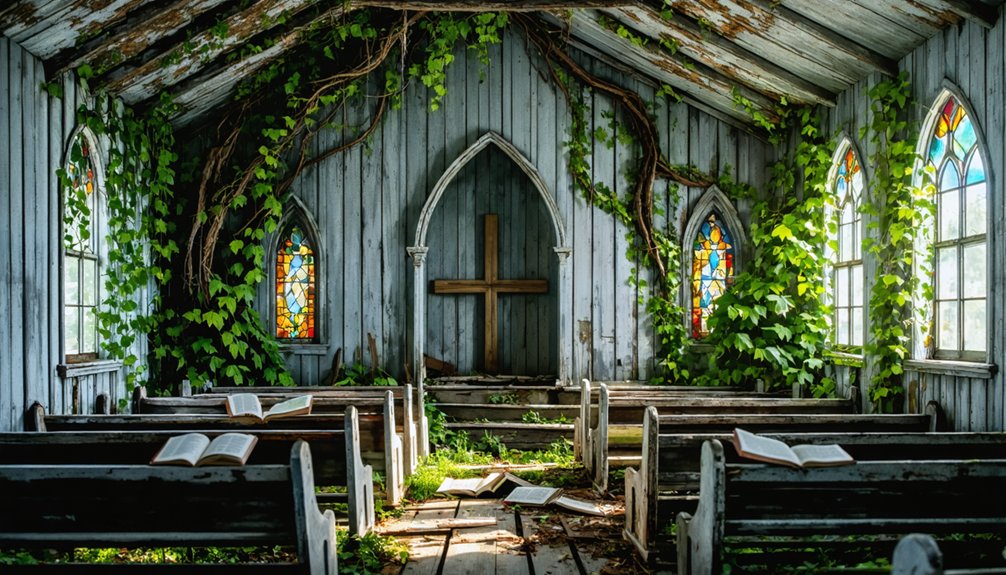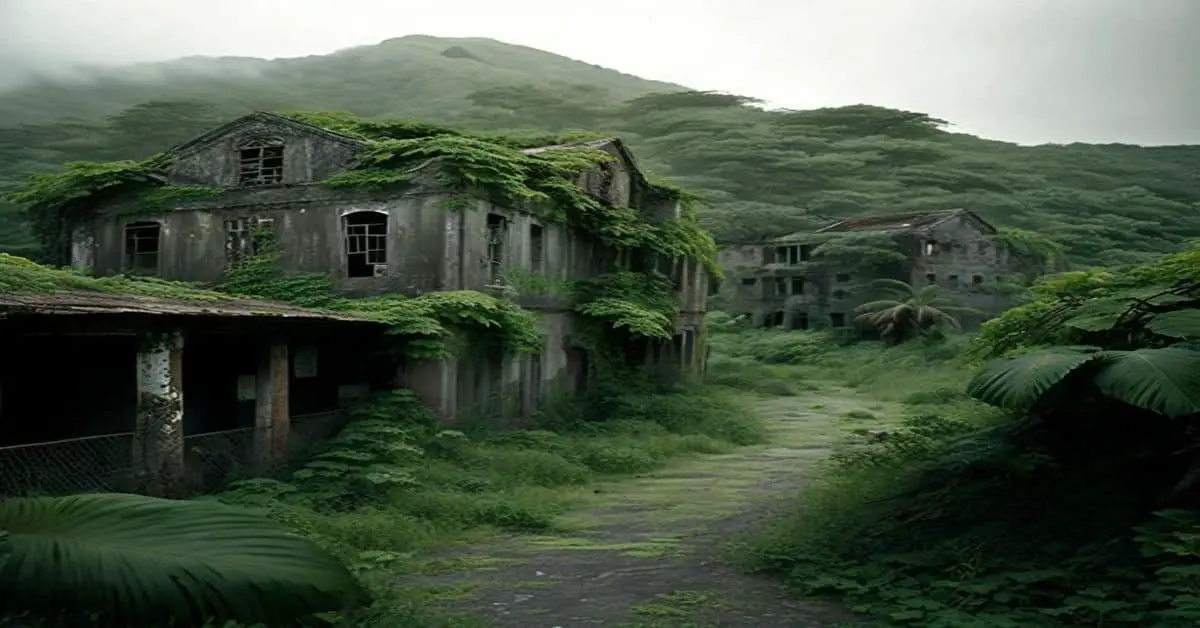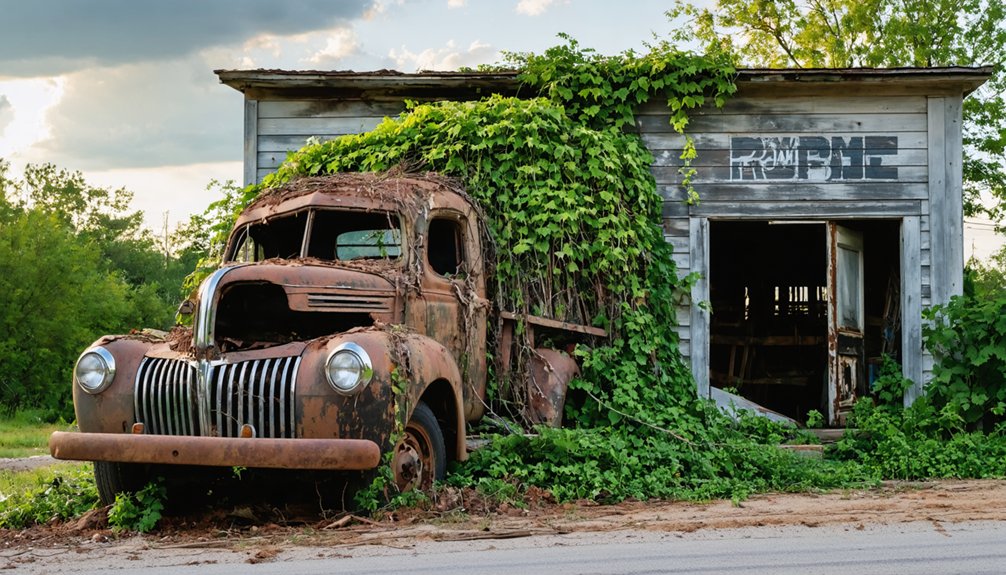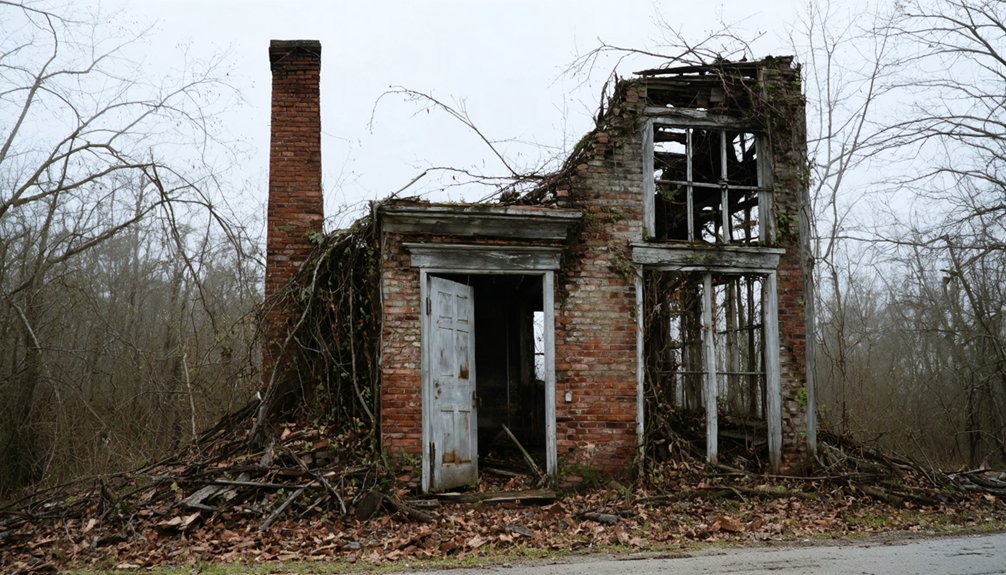You’ll find the haunting ruins of Cahaba, Alabama’s first state capital, at the confluence of the Alabama and Cahaba Rivers. Once a thriving city of 3,000 residents, this ghost town served as both a major cotton shipping hub and Civil War prison site. Today, you can explore the Old Cahawba Archaeological Park‘s preserved remnants, from Native American mounds to antebellum mansion columns. Local tales hint at supernatural encounters along the park’s historic paths and riverfront.
Key Takeaways
- Cahaba was Alabama’s first state capital in 1818 before becoming a thriving river town with over 3,000 residents by the Civil War.
- Located at the confluence of Alabama and Cahaba Rivers, the town served as a major cotton shipping hub and commercial center.
- Environmental challenges, including devastating floods and the loss of railroad infrastructure during the Civil War, contributed to the town’s decline.
- The loss of county seat status to Selma in 1866, combined with post-war economic struggles, led to the town’s eventual abandonment.
- Now preserved as Old Cahawba Archaeological Park, the site features historic ruins, cemeteries, and reported paranormal activity.
Native American Origins and Early Settlement
While the modern ghost town of Cahaba may be known as Alabama’s first state capital, its history stretches back over four millennia to its Native American origins.
The site flourished as a thriving center of Mississippian culture between AD 1000 and 1550, where you’ll find evidence of an impressive fortified village that dominated the landscape.
At the heart of this settlement stood a flat-topped mound, protected by a semi-circular defensive wall and moat.
Archaeological evidence shows the village maintained trade connections with groups from Moundville and Pensacola regions.
You’ll discover that this strategic location at the confluence of major waterways made it a vital Native American trade hub, connecting various Mississippian groups along the Alabama and Cahaba Rivers.
Both Choctaw and Creek peoples influenced the region, with the Cahaba River serving as a natural boundary between their territories.
The land opened up to white settlement following the Creek Nation’s defeat in 1814.
From State Capital to Bustling River Town
At the confluence of the Alabama and Cahaba Rivers, you’ll find the strategic location that made Cahaba an ideal choice for Alabama’s first state capital in 1818.
Though the capital building’s construction and early government operations faced challenges from flooding and disease concerns, you can trace how these issues led to the capital’s relocation to Tuscaloosa in 1826. William Wyatt Bibb, Alabama’s first governor, oversaw much of the initial development during this period.
Despite losing its political status, you’ll see how Cahaba transformed into a thriving commercial center, leveraging its riverside position to become a major cotton shipping hub with over 3,000 residents by the Civil War. Today, historical researchers frequently use disambiguation pages to distinguish this ghost town from other locations sharing the Cahaba name.
Strategic River Location
Located at the strategic confluence of the Cahaba and Alabama Rivers, Cahaba emerged as an essential settlement point that would shape Alabama’s early development.
You’ll find this 194-mile waterway at the heart of a vast 1,870-square-mile drainage system within the Mobile River Basin, where it has sustained both human settlements and remarkable river ecology for centuries.
Before European settlement, Choctaw communities and Mississippian mound builders recognized the area’s potential, calling it Ika Uba.
The river’s economic significance later attracted settlers who’d build Birmingham and surrounding communities.
The city served as Alabama’s capital from 1820 to 1825 before facing economic hardships and disease outbreaks.
You’ll discover one of America’s most biologically diverse river systems here, where the waters have consistently provided crucial resources for urban development while maintaining their natural splendor, making it a critical cornerstone of Alabama’s geographical and cultural heritage.
Political Power Shifts
Despite its promising start as Alabama’s first permanent state capital in 1819, Cahaba’s political prominence proved short-lived. The shifting political dynamics centered on persistent flooding from the Alabama and Cahaba Rivers, along with health concerns about malaria and yellow fever.
You’ll find that relocation debates intensified as legislators questioned the town’s suitability, ultimately voting to move the capital to Tuscaloosa in 1825 by a single vote margin.
While you might expect this political setback to destroy the town, Cahaba adapted and transformed. Through the 1840s and 1850s, it reinvented itself as a thriving river port, capitalizing on the cotton boom. The town experienced a significant economic revival as river transportation made it a vital commercial hub.
Even after losing the state capital status, it maintained its position as Dallas County’s seat until 1866, showing remarkable resilience in the face of political change.
The Rise of Cotton Commerce and Trade
When Cahaba lost its status as Alabama’s state capital, the town quickly reinvented itself as a thriving cotton distribution hub within the fertile Black Belt region.
You’d find the town’s prosperity deeply rooted in its strategic location along the Alabama River, where rich, dark soil yielded abundant cotton harvests that didn’t deplete as quickly as other southern lands.
The town’s cotton production and trade networks expanded dramatically after Creek Indian treaties opened millions of acres for cultivation. As a key shipping point, the town connected local farmers directly to the profitable Mobile port.
By 1860, you’d see steamboats like the Tensas and Harriet regularly traversing the river, while the newly built railroad enhanced shipping efficiency.
Cahaba’s success was evident in its grand mansions, bustling warehouses, and a population of 2,000 – the majority being African Americans who sustained the cotton economy through their labor.
The town became a significant contributor to the South’s dominance in world cotton supply, as the region produced three-fourths of global cotton during this period.
Castle Morgan and the Civil War Years
When you visit Cahaba’s Castle Morgan site today, you’re standing where thousands of Union soldiers once endured imprisonment in a converted cotton warehouse that measured 193 by 116 feet.
Despite the prison’s overcrowded conditions within its 14-foot brick walls and wooden stockade, you’ll learn that Confederate officials maintained relatively humane standards here, resulting in fewer deaths than at other Southern POW camps.
The prison’s strategic location near the Alabama and Cahaba rivers made it an important transfer point in the Confederate prisoner exchange network, though flooding in 1865 created additional hardships for those confined within its walls. The site operated under the command of Captain H.A.M. Henderson, who was remembered by prisoners for his comparatively humane treatment of inmates.
Prison Life and Conditions
As the Civil War intensified in 1863, Castle Morgan emerged as a Confederate prisoner-of-war camp in Cahaba, Alabama, housing Union soldiers within a converted 15,000-square-foot brick cotton warehouse.
While you’d have found the prison initially designed for 500 men, by late 1864 you’d have witnessed over 2,151 prisoners crammed inside, eventually swelling to more than 3,000.
Daily prisoner routines involved daytime yard access, though cooking areas consumed one-third of the outdoor space. At night, you’d have been locked inside with just six square feet per person – the most crowded conditions of any Civil War prison.
Despite severe overcrowding issues, you might’ve glimpsed prisoners occasionally walking through town, and some even praised Captain Henderson’s relative kindness, though Lt. Col. Jones’s drunken brutality cast a dark shadow over the camp.
Military Strategy and Control
Though strategically positioned far from the front lines, Castle Morgan played an essential role in the Confederacy’s prisoner management system from 1863 onwards.
As part of their military logistics, the Confederates converted an unfinished warehouse into a prison facility at the junction of two major rivers, creating a secure detention center far from Union reach.
- You’ll find the prison’s design reflects careful military planning, with its 12-foot stockade and elevated guard walks enabling efficient surveillance.
- You can see how the Confederates maximized limited space by housing over 3,000 prisoners in an area smaller than a football field.
- You’ll notice the strategic advantage of Cahaba’s location, which helped maintain better conditions than notorious camps like Andersonville.
- You’ll understand how the prison’s role as a collection and transfer point streamlined prisoner management across the Confederate territory.
Prisoner Exchange Negotiations
Despite its remote location, Castle Morgan played a pivotal role in the Confederacy’s prisoner exchange system from 1863 to 1865, serving as both a holding facility and transfer hub for Union POWs.
You’ll find that the prison’s relatively humane prisoner treatment set it apart from other Confederate camps, contributing to a lower mortality rate that strengthened its position in exchange negotiations.
Operating under the Dix-Hill Cartel framework, the camp’s exchange logistics involved coordinating transfers of up to 3,000 prisoners within its 15,000-square-foot warehouse compound.
While overcrowding posed challenges, the commandant’s fair treatment policies helped maintain order during negotiations.
The camp’s strategic location at the confluence of the Alabama and Cahaba Rivers made it an ideal transfer point, though seasonal flooding in 1865 complicated some exchanges.
Factors Leading to Abandonment
When Alabama’s first state capital fell into decline, multiple devastating factors converged to seal its fate. The town’s economic decline accelerated rapidly as environmental challenges proved insurmountable for its resilient citizens.
- You’ll find that the Confederate government’s seizure of Cahaba’s railroad iron dealt a crushing blow, severing essential transportation links that had made the town a thriving cotton distribution hub.
- The recurring floods, especially the devastating one in 1865, literally washed away the town’s hopes for recovery.
- You can trace how losing the county seat to Selma in 1866 stripped away remaining administrative significance.
- The perfect storm of post-war economic struggles and the town’s low-lying position forced most residents to seek opportunities elsewhere, transforming a once-proud capital into an abandoned shell.
Archaeological Discoveries and Preservation
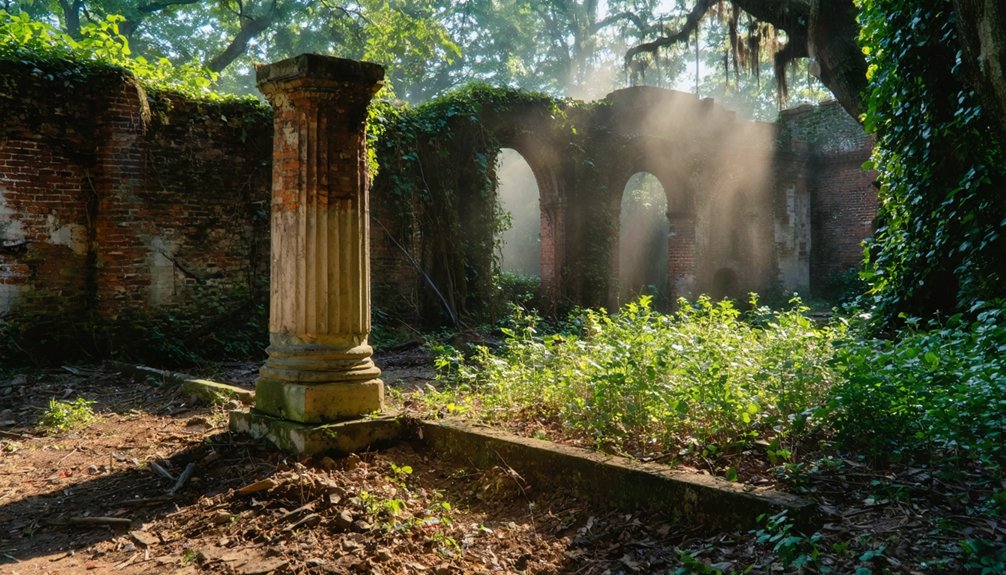
As layers of history converge at Old Cahawba Archaeological Park, you’ll discover a rich tapestry of civilizations spanning from the Mississippian culture through Alabama’s first capital period.
The site’s archaeological significance is evident in the remnants of a half-acre mound, defensive walls, and moat that once protected a thriving indigenous trade hub.
While exploring the park’s trails, you’ll encounter preserved elements including government building ruins, ornamental wellheads, and the iconic Crocheron mansion columns.
Free bike rentals make it easy to navigate the extensive grounds, where interpretive signs detail everything from pre-Columbian trade networks to Civil War history.
Despite challenges from floods and natural decay, preservation techniques have maintained key features like historic cemeteries and portions of the original earthworks, allowing you to experience centuries of Southern heritage firsthand.
Tales of the Supernatural
Beyond the archaeological remnants and historic ruins, Cahaba harbors a rich supernatural legacy that’s earned it recognition among the world’s spookiest ghost towns.
You’ll find the most intense paranormal activity at the “New Cemetery,” where visitors frequently report hearing phantom children’s laughter during daylight hours.
The site’s most famous ghostly encounter involves Pegue’s ghost, a white orb that’s said to follow visitors near the cedar maze.
- Experience sudden temperature drops and whispers while exploring the town’s isolated riverfront paths
- Join guided Haunted History Tours with professional paranormal investigators
- Witness spectral sightings during daytime park hours (9 a.m. to 5 p.m.)
- Discover locations where generations of local folklore merge with documented supernatural phenomena
Historical Figures and Notable Visitors
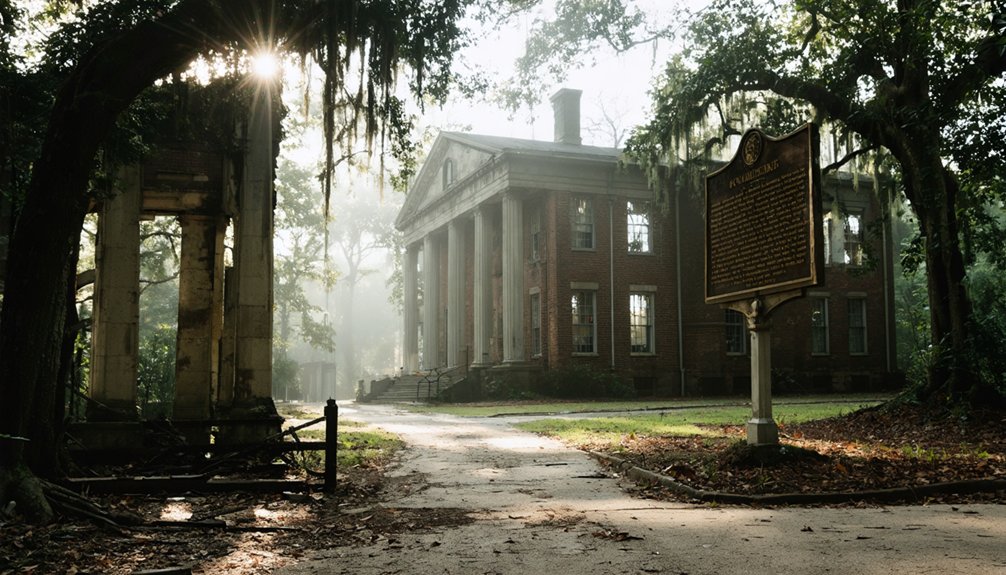
Throughout its brief but significant tenure as Alabama’s first state capital, Cahaba attracted influential figures who shaped the region’s political and economic landscape.
You’ll find the footprints of founding figures like early governors and legislators who crafted Alabama’s foundational laws within the town’s historic boundaries.
Among the notable visitors and residents, you’ll discover Stephen Barker, whose impressive brick mansion and unique two-story slave quarters reflected the town’s antebellum prosperity.
W.W. Fambro emerged as a community leader, opening his home to educators and students while serving on the Cahaba Academy board.
During the Civil War, Confederate General Nathan Bedford Forrest and Union General James H. Wilson met at the Crocheron mansion to negotiate prisoner exchanges, marking one of the town’s most significant historical encounters.
Frequently Asked Questions
Can Visitors Camp Overnight at the Old Cahawba Archaeological Park?
You can’t camp overnight at Old Cahawba Archaeological Park. The park’s camping regulations prohibit overnight stays, and visitor amenities are limited to daytime use from 9am-5pm only.
What Is the Best Time of Year to Visit Cahawba?
Like stepping into a living history book, you’ll want to visit between March and May when mild weather, blooming wildflowers, and fewer crowds let you freely explore the historical significance without summer’s heat or fall’s crowds.
Are There Guided Tours Available in Languages Other Than English?
Currently, you won’t find guided language tours in anything but English. There’s no evidence of multilingual guides or cultural experiences offered in other languages at the site.
How Accessible Are the Ruins for Visitors With Mobility Challenges?
You’ll find most ruins easily accessible, with wheelchair access on paved paths and smooth roads. The Clear Creek Nature Trail’s firm surface welcomes mobility aids, though some dirt paths require caution in wet conditions.
What Happened to the Original Buildings and Materials After Abandonment?
You’ll find most buildings fell to fire, decay, or dismantling by 1900. Locals salvaged architectural remnants for other projects, while remaining structures deteriorated until historical preservation efforts began protecting the few surviving ruins.
References
- https://encyclopediaofalabama.org/article/cahaba/
- https://en.wikipedia.org/wiki/Cahaba
- https://www.selmatimesjournal.com/2023/10/19/cahawba-listed-as-one-of-worlds-10-spookiest-ghost-towns/
- https://ahc.alabama.gov/CahawbaHistoryFacts.aspx
- https://www.battlefields.org/visit/heritage-sites/old-cahawba-archaeological-park
- https://www.blueridgeoutdoors.com/go-outside/ghost-towns-of-old-cahawba/
- https://alabamamoundtrail.org/mound-site/old-cahawba/
- https://www.tripadvisor.com/Attraction_Review-g30754-d3405413-Reviews-Old_Cahawba_Archaeological_Park-Orrville_Alabama.html
- https://cahawba.com/history-and-legacy/the-road-to-statehood/
- http://gibsonfamilyhistory.com/leeds.php
